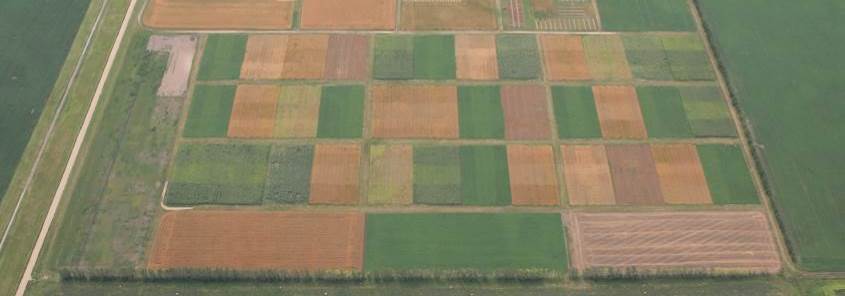Long-term Cropping Systems Study
In 1987, a long-term cropping systems study started at the NDSU Carrington Research Extension Center. Three sets of 4-year crop rotations are replicated three times each year. The seventh cycle ended in 2014.
The original base rotation, maintained until 2003, was: Hard Red Spring Wheat/Sunflower/Barley/Fallow. At the beginning of the fifth cycle in 2003, the base rotation was updated to replace Fallow with Soybean. The other two current rotations are: Hard Red Spring Wheat/Field Pea/Corn/Soybean, and Hard Red Winter Wheat/Corn/Soybean/Canola. The last rotation includes a cover crop vs. no cover crop component after Hard Red Spring Wheat and Soybean are harvested each year. Each crop within each rotation is planted every year.
The fertilizer treatments are: (1) urea broadcast applied each spring to all plots, except field peas and soybeans, at 0, 50, or 100 pounds of N per acre and (2) composted beef feedlot manure applied once at 200 pounds of N the first year of each cycle. These treatments are imposed in strips perpendicular to the three tillage systems: conventional, minimum tillage, and no till resulting in 12 sub-plots within each crop.
Data is collected consistently on total crop biomass, grain production, and the effects of crop rotations, tillage system, and N fertility treatments on subsequent crops. Soil data on nitrogen, phosphorous, organic matter, and pH is also collected.
Data on soil moisture status, soil aggregate stability, weed pressure and disease pressure have also been collected as time and resources have permitted.
The goal of the study is to determine the affects of tillage system, N fertility level and source, and crop rotation and the combination of these parameters have on crop grain and biomass production, crop diseases, soil nitrogen, soil phosphorous, soil organic matter, and soil pH.

In this photo you can see the different crop plots with the tillage systems
running vertically and the N fertility rates running laterally in the plots.
Some key long term findings from this and previous cycles are:
- Normal precipitation and temperature at our location shows no differences in yield based on tillage system.
- Soybean yields are the same whether it follows wheat, barley, or corn.
- Corn following field pea has a significantly higher yield (6.5 bu/acre) than corn following winter wheat.
- The no-till system has significantly higher organic matter content at 3.7% than conventional tillage at 3.4%, and minimum tillage at 3.5%.
- Composted manure plots have significantly higher organic matter content at 3.8% than the 100 lbs. urea plots at 3.6%, the 50 lbs. urea plots at 3.5%, and the no fertilizer plot at 3.3%.
- Composted manure plots have significantly higher soil pH at 7.2, than the no fertilizer plots at 6.6, the 50 lbs. urea plots at 6.4, and the 100 lbs. urea plots at 6.0.
- Composted beef feedlot manure is an excellent economical fertilizer if available. Crop yields are equal to and some times greater than equivalent amounts of commercial nitrogen fertilizer. Find out more about the economics here: http://www.ag.ndsu.edu/CarringtonREC/center-points/economics-of-a-long-term-cropping-system-at-the-carrington-rec.
Ezra Aberle
Agronomy Research Specialist


